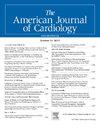Impact of Peripheral Arterial Disease on Clinical Outcomes of Patients Undergoing Complex vs Noncomplex Percutaneous Coronary Intervention
IF 2.3
3区 医学
Q2 CARDIAC & CARDIOVASCULAR SYSTEMS
引用次数: 0
Abstract
Peripheral arterial disease (PAD) often predicts poor outcomes in patients undergoing percutaneous coronary intervention (PCI). Here we examine the impact of PAD in patients receiving complex PCI (CPCI) and noncomplex PCI. Patients undergoing PCI at the Mount Sinai Hospital between 2012 and 2022 were stratified by the presence of CPCI and PAD. The primary outcome was major adverse cardiovascular events (MACE), a composite of death, myocardial infarction, target vessel revascularization, or stroke within 1 year; secondary endpoints included bleeding events. An adjusted Cox proportional hazard method was used to evaluate risks of each outcome within each subgroup. Among 20,376 patients, 8,200 (40.2%) had CPCI and 1,959 (9.6%) had PAD. PAD patients were older and more likely to be female and have risk factors such as diabetes and smoking and were more commonly discharged with anticoagulants. 1-year risk of MACE was significantly higher for patients with PAD in both CPCI (19.6% vs 14.4%, adj. hazard ratio [HR] 1.31, 95% confidence interval [CI] 1.08 to 1.58, p = 0.006) and no-CPCI strata (13.9% vs 9.2%, adj. HR 1.35, 95% CI 1.12 to 1.64, p = 0.002; p-interaction = 0.349). Bleeding events were also more frequent in PAD patients for CPCI (8.5% vs 5.5%, adj. HR 1.40, 95% CI 1.07 to 1.84, p = 0.014) and no-CPCI (7.1% vs 4.3%, adj. HR 1.52, 95% CI 1.18 to 1.96, p = 0.001; p-interaction = 0.608). In conclusion, presence of PAD is associated with a significantly increased risk of MACE and bleeding after PCI, regardless of procedural complexity.

外周动脉疾病对复杂与非复杂经皮冠状动脉介入治疗患者临床结局的影响
外周动脉疾病(PAD)通常预示着接受经皮冠状动脉介入治疗(PCI)的患者预后不良。在这里,我们研究了PAD对接受复杂PCI (CPCI)和非复杂PCI患者的影响。2012年至2022年在西奈山医院接受PCI的患者根据CPCI和PAD的存在进行分层。主要转归是主要心血管不良事件(MACE),即1年内死亡、心肌梗死、靶血管重建术或卒中的综合结果;次要终点包括出血事件。采用调整后的Cox比例风险法评价各亚组内各结局的风险。在20,376例患者中,8,200例(40.2%)患有CPCI, 1,959例(9.6%)患有PAD。PAD患者年龄较大,多为女性,有糖尿病和吸烟等危险因素,出院时更常使用抗凝血剂。在CPCI组(19.6%比14.4%,95%可信区间(CI) 1.08-1.58, P= 0.006)和无CPCI组(13.9%比9.2%,HR 1.35, 95% CI 1.12-1.64, P = 0.002)中,PAD患者1年MACE风险均显著高于CPCI组(19.6%比14.4%,95%可信区间(CI) 1.08-1.58, P= 0.006);P-interaction = 0.349)。伴有CPCI的PAD患者出血事件也更频繁(8.5%比5.5%,HR 1.40, 95% CI 1.07-1.84, P = .014),无CPCI的PAD患者出血事件更频繁(7.1%比4.3%,HR 1.52, 95% CI 1.18-1.96, P = . 0.001;P-interaction = 0.608)。总之,PAD的存在与PCI术后MACE和出血的风险显著增加相关,与手术复杂性无关。
本文章由计算机程序翻译,如有差异,请以英文原文为准。
求助全文
约1分钟内获得全文
求助全文
来源期刊

American Journal of Cardiology
医学-心血管系统
CiteScore
4.00
自引率
3.60%
发文量
698
审稿时长
33 days
期刊介绍:
Published 24 times a year, The American Journal of Cardiology® is an independent journal designed for cardiovascular disease specialists and internists with a subspecialty in cardiology throughout the world. AJC is an independent, scientific, peer-reviewed journal of original articles that focus on the practical, clinical approach to the diagnosis and treatment of cardiovascular disease. AJC has one of the fastest acceptance to publication times in Cardiology. Features report on systemic hypertension, methodology, drugs, pacing, arrhythmia, preventive cardiology, congestive heart failure, valvular heart disease, congenital heart disease, and cardiomyopathy. Also included are editorials, readers'' comments, and symposia.
 求助内容:
求助内容: 应助结果提醒方式:
应助结果提醒方式:


